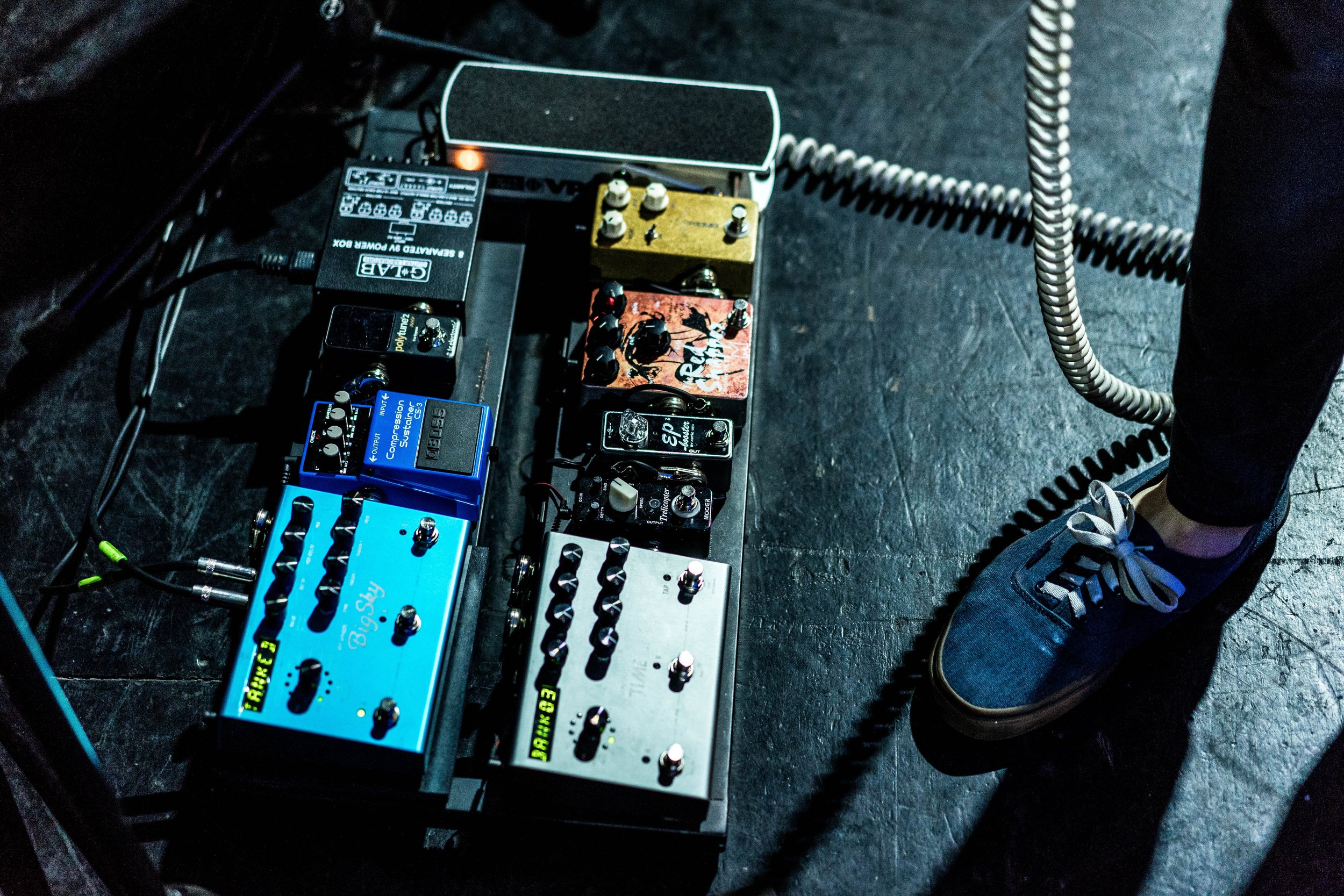Learning guitar is very exciting! It’s a profound experience to take an organic instrument and chisel away at a song, technique or musical idea and over time, be able to express yourself through sound.
While enjoyable, getting started with learning something new can feel like a daunting task. If you are serious about learning guitar or improving your current skill-set, it’s important to have all the materials and advice necessary to make the most of your process.
The following list is an introductory overview of what many players use or practice to progress on the instrument. Categories range from essential, suggested and optional. I'll create anchor links of everything discussed below in case you want to jump to a specific section. Hopefully you leave this post feeling more informed and ready to pick up a guitar!
Essential Items
Guitars - There are two common types of guitars that beginning players typically choose to learn: acoustic or electric. There are subsets of styles within electric and acoustic guitars (such as stratocaster, Les Paul, archtop, acoustic-electric, classical/nylon, etc). Beginning players should choose a guitar based on the type of music that inspires them the most to play and practice consistently.
If you are mainly interested in rock, blues, or metal, you should start learning on an electric guitar. Keep in mind that if you go this route, you will need an amplifier and a guitar cable.
If you’re the minimalist type and don’t want to worry about extra accessories, or are primarily interested in singer/songwriter, classical, folk, or fingerstyle, you should learn on an acoustic or classical guitar.
Picks - Picks are made in a variety of different materials ranging from plastic, wood, metal, stone, felt, nylon… even tortoise shell until it was banned in the 1970’s! Most players now use picks made of plastic. I recommend experimenting with different brands, thicknesses, shapes and textures, as these can all result in slightly different tones. At the end of the day, it’s about finding what works for you.
It is important to note that some people play fingerstyle guitar and don’t use picks. I teach my students both methods, as it’s always a good idea to keep your options open.
Guitar Tuner - Guitar tuners have evolved considerably over the years. Early options mainly consisted of using a tuning fork, pitch pipes, or tuning the guitar off of the notes on a piano or keyboard. While these traditional tuning devices and methods are still around, most musicians today use some type of electronic tuner or tuning app.
There are multiple types of electronic tuners on the market today. Standalone models have a built in microphone and lcd display screen to show you what pitch you’re on. Tuning apps can also be downloaded to your phone and essentially work the same way as the standalone guitar tuners. Clip-on lcd models attach to the headstock of the guitar and use a vibration sensor to determine the pitch of the note you’re playing. I recommend investing in a clip-on vibration sensor tuner, as they are easy to use and will not pick up residual background noise, as the standalone microphone models tend to do.
While there are a variety of models to choose from, guitarists need to tune consistently and sometimes frequently. Remember to pick one up if you’re new to the guitar.
Guitar Amplifiers (*Essential for Electric Guitars Only) - There are two main types of amps: tube amps, solid-state amps (sometimes referred to as transistor amps), and even a combination amp that uses both tube and solid state electronics.
Solid-state amps are generally lighter and cheaper in cost. Because solid-state amps don’t have vacuum tubes that will occasionally need to be replaced, they are easier to maintain over the years.
Tube amps have a reputation of sounding “warmer” than solid state amps and the overdrive effect has a smoother sound. More traditional rock and blues players prefer tube amps over solid state due to the warmth and character that the tubes provide.
Amp preference is subjective. Experiment a little, find something that sounds good to you, and rock it!
Guitar Cable (*Essential for Electric Guitars Only) - When purchasing a guitar cable, it’s important to make sure it is of proper length and with enough slack to make sure it isn’t constantly tugging on your amp. Guitar cables usually wear out over time, so consider spending the extra money on something that has a lifetime warranty. Having a backup is also a good idea in case your primary cable stops working.
Suggested Items
Guitar Strap - Guitar straps are used to keep the guitar in a comfortable playing position as you play. The strap helps support the weight of the instrument and keeps the neck at an incline which reduces wrist strain. Guitar straps are absolutely necessary if you plan on playing/performing while standing. If you primarily play or perform while sitting, they aren’t completely needed, but still helpful and recommended.
Guitar Case/Gig Bag - It’s inevitable that most guitars over time will develop scratches and dings with regular use. Having a hard case for your guitar will result in maximum protection for your instrument. Do keep in mind that hard cases cost considerably more than soft cases, so if your guitar isn’t extremely valuable, it might not be totally worth the higher price tag. Gig bags or soft guitar cases are also lighter and can usually be carried around your shoulder for portable convenience.
Metronome- A metronome is designed to help musicians maintain perfect or near perfect time. Although metronomes have evolved over the years into different shapes and styles, they all essentially do the same thing: steady your rhythm.
While classic metronome models have a moveable arm that swings back and forth, there are newer options like electronic metronomes and even metronome apps that you can download straight to your phone. Incorporating a metronome of any kind into your practice can vastly enhance your routine.
Music stand with a stand light - Having a music stand helps with your posture while playing seated, and (bonus) keeps your book open! There are low-cost thin wire music stands, or more expensive models that are made of a heavier steel. If you don’t mind the higher cost, I recommend investing in the heavier stand as they generally last longer and are less prone to being knocked over.
A stand light clips on top of the music stand. It’s not essential to have one, but it definitely helps if you’re playing in a dark or semi-dark room so you don’t have to strain your eyes to see your music or method book.
Private Lessons - Taking private guitar lessons provides a personalized and highly effective level of education. Private lessons help students learn proper technique and tone production, and come loaded with personal feedback. Lessons also help to keep students accountable to practice due to the regular commitment. However, all of that comes at the cost of an instructor’s monthly fee.
I recommend lessons if you are wanting to make significant progress on the instrument or if you learn better in a structured environment. If you’re too busy to commit to regular lessons, or you’re just getting started and aren’t sure of your level of interest, private lessons may not be worth the expense. It’s a personal decision that requires some consideration.
Music Apps & YouTube Tutorials - These are very beneficial if you are looking for a low or no-cost method of learning guitar. Apps and video tutorials can also be used in conjunction with private lessons if your instructor approves of the information being covered.
That being said, internet learning can be overwhelming due to the wide array of information, (or misinformation) you may come across. Furthermore, exclusively learning through videos or apps lacks the personal feedback you may need to learn proper technique or tone production.
If you are new to guitar, YouTube videos, music apps or any guitar instruction website can be great in helping you get started. If this method works for you, by all means, stick with it! If you start to notice a lack of progress or feel stuck and without direction, private lessons with the right instructor may help get you over any hurdles you’re experiencing.
Method Books - Working out of a method or artist book can help provide direction in your practice routine. While they may feel dull at times, method books provide a stable base of information that many beginning and intermediate players can benefit from, and can inspire a sense of progress the further you get.
Extra Guitar Strings- Guitar strings need to be replaced regularly (every 3-6 months on average) to ensure proper tone and instrument care. Additionally, strings do break from time to time. Having a backup set is a good idea. If you haven’t yet, check out my previous blog post that discusses guitar strings in more detail.
Guitar Cleaner/Polish and Cleaning Cloth - Whenever you replace your guitar strings, it’s a great idea to clean the fingerboard of your guitar with the proper cleaner. Over time, dirt and oils from your fingers will accumulate on the neck. Cleaning your instrument regularly will prolong its life and help keep it looking new over the years.
Practice Space with a Guitar Stand - Environment matters when starting a new routine! Having a dedicated practice space where your guitar is visibly secured in a guitar stand will encourage you to pick up the instrument and practice more than if it’s stowed away in a case.
Capo- Guitar capos clamp down across the guitar neck and shorten the length of the strings. Guitarists primarily use capos to avoid using barre chords for certain songs. They can also be used to play more intricately over chord changes by using slurs such as hammer-ons and pull-offs.
There are different styles of guitar capos, the most common being quick change, which uses a metal spring to attach to the guitar neck, and screw-on, which uses a metal screw to tighten or loosen the tension of the capo to the guitar neck. I recommend quick change capos for adults, as they are faster to clamp on. Screw-on capos are better suited for kids because they don’t require as much force to operate.
Consistent/Daily Practice Routine - Find a time of day and amount of time that fits your daily schedule to practice (I personally need to practice in the mornings or midday). It helps to create events in your calendar to practice. This can ensure that it becomes a consistent part of your daily routine.
Play Music with a Friend or Small Group - Having a friend or joining an online group to help motivate you is a great way to keep your practice routine consistent and effective. If you can find people to play with, you’ll not only grow your performance experience, but will have a lot of fun and develop a variety of additional music skills. You’ll learn how your sound contributes to the overall sound of the group and gain an opportunity to trade feedback and discuss songs, music theory or any other shared interests.
Optional Items
Guitar Effect Pedals - There are a variety of guitar effect pedals and multi-effect pedals to choose from. Common types of pedals or sound effects are distortion/overdrive, wah-wah, delay, volume, chorus, etc. If you like the sound of guitar effects and effect pedals, I recommend going to your local music store to demo a few. Most shop employees will be more than happy to get you set up with whatever you are interested in.
Summary
When learning guitar, above all else, make sure to manage your expectations! Learning guitar is extremely fun and rewarding. However, like most things in life, you have to maintain a consistent and effective routine if you want to improve. While not everything listed above is absolutely necessary, it’s a good idea to consider everything and try to implement all the tools and advice you can to get the most out of your practice routine. Play on!







